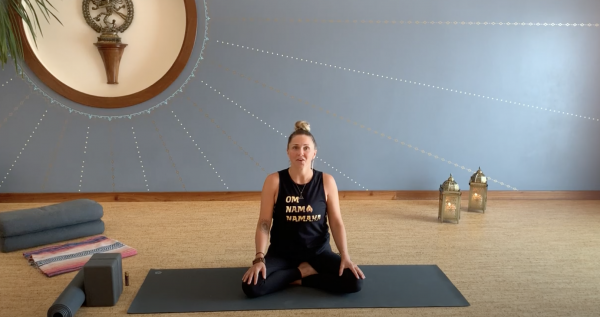
“Start to settle in to a deeper sense of peace,” said Katey Inman in a calm, measured voice spoken over the rhythmic hum of a harmonium.
“(Though) we may be separated by space, there is a matrix of energy connecting every human being, every living being,” she said, winding down an hour-long morning yoga class.
At times, the words were hard to make out, because the virtual teleconferencing app Inman uses to hold classes of late cannot cleanly differentiate voices from music.
For the last few weeks, since health mandates shut down gyms and fitness facilities to prevent spread of the coronavirus, Inman and other fitness businesses have adapted in creative ways to try and keep clients, hoping to stay afloat. But many worry that even if they can make it through the immediate uncertainty of government-directed closures, their businesses will shrink and remain hobbled into the foreseeable future.
Inman is one of the owners of Anchorage Yoga and Cycle, a pair of exercise studios. In normal times, clients are often stacked up on digital waitlists in order to stretch out mats or pedal through intense stationary bike sessions. But all that vigorous, sweaty exertion depends on dozens of people being very close together. Which, under social distancing, has ground to a halt.
“We’ve lost 30 percent of our members,” Inman estimated.
AYC charges people for drop-in classes, but they get a steady, reliable flow of revenue from monthly memberships. And like many other fitness businesses in Alaska, membership fluctuates seasonally, peaking in the winter months, and declining toward the summer as people are opt outside for exercise. According to Inman, if that annual trend happens this year, revenue will be down 50 percent within the next few months. The prospect set them scrambling to set up virtual classes over teleconferencing service Zoom.
“I have to tell you,” she said, “I had no idea even what Zoom was. I mean, that’s how not connected to technology I am.”
The goal now, Inman said, is to keep membership clients “tethered” to the studio with some semblance of routine and an experience resembling group classes. They’re trying other things, too: reducing membership prices, as well as posting free yoga videos on YouTube and Instagram.
The cycle component is a lot trickier, though. For a yoga class, one needs essentially just a mat, an internet connection, and some floor space. Stationary exercise bikes, however, are in shorter supply. Inman said the studio sold off 28 of its older machines that had been stored in a shipping container, but the demand from clients was far beyond what they expected.
“We had a waitlist of 200 people,” she said.
Across the country, gyms and fitness studios are switching over to virtual offerings as a way to weather the pandemic and give clients a release valve while cooped up inside. Larger local operations like the Alaska Club and YMCA have been posting classes and modifying membership dues. But taking highly intimate, physical activities and putting them on a computer screen is far from ideal.
“It’s completely different talking in front of a camera, I’m terrible at it,” said Billy Crumm, who runs Elite Sports Performance, a functional fitness gym in Anchorage that does a lot of group exercise classes.
“I think we’re starting to get the hang of it,” he added.
Lately, he’s been posting short workout videos to Facebook that require little to no equipment.
Crumm’s also doing some one-on-one personal training sessions over FaceTime. And rather than letting equipment gather dust, the gym is renting out some of it so people can use it at home. Those alternate revenue streams are not closing the Elite’s financial gap, though. In the meantime, the business applied for federal assistance, and is working with its landlords. Not only is the approaching summer gym lull a bleak financial prospect, but Crumm suspects people’s health concerns will linger long after government mandates are lifted.
“I think ultimately it’s just going to take some time for people to get comfortable in group environments, basically,” he said.
Inman had similar predictions.
“I can say with absolute certainty that the landscape will change dramatically for our industry,” she said.
Her business, like plenty of others across the economy, has had to lay off staff or reduce hours. And that’s not something that can be flipped back like a switch.
“I know that we are not going to be able to come back and operate at full capacity because we’ve let so many of our full time staff go,” she said. “It’s going to take a moment to restructure and reorganize.”
Inman thinks one advantage she has over other small business owners struggling with the current moment is that yoga instruction requires her focus on what she can and cannot control. And a global pandemic, she said, is very much in the “cannot control” category.
Zachariah Hughes reports on city & state politics, arts & culture, drugs, and military affairs in Anchorage and South Central Alaska.
@ZachHughesAK About Zachariah




